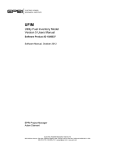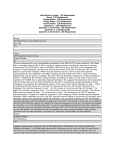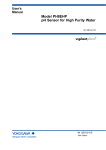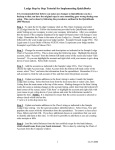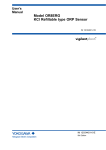Download UFIM Newsletter 2011 - S.Chapel Associates
Transcript
S.Chapel Associates December 2011 UFIM News The second issue concerns how to characterize burn reduction costs when a generation plant, during some time periods, is needed for voltage support or other services that do not involve pure economic dispatch. Each of these issues is discussed here. A third technical issue arose because one company was attempting to use UFIM to determine the appropriate amount of firm natural gas transportation to put under contract. Each of these issues are discussed below. Welcome This is the second UFIM Newsletter. This second newsletter is being provided by S.Chapel Associates to all UFIM users. In the future the intended audience are active users of the Utility Fuel Inventory Model who have purchased the annual UFIM Software and User Support Service from S.Chapel Associates. Current plans are to publish the newsletter once a year and to cover at least the following topics: • • • • • Specifying Disruption Probabilities News Technical Discussions Training and User Support Software Maintenance Miscellaneous Items In UFIM for any given month there are two possible states - disruption and normal. In addition, the model assumes that disruptions are mutually exclusive - that is two or more disruptions cannot occur at the same time.1 The implication of these two assumptions is the following: Suppose you have two disruptions A and B. The general formula for the probability of A or B occurring is: I welcome comments, suggestions and any other input that the active UFIM users might want to provide. Email Stephen Chapel P (A or B) = P (A) + P (B) − P (A and B). News But because in UFIM the disruptions are mutually exclusive (P (A and B) = 0), P (A or B) = P (A) + P (B). The result is for any month the sum of disruption probabilities must be ≤ 1.0. In our example P (A) + P (B) must be ≤ 1.0. To compute the probability of a disruption occurring in a given month you need to know (1) the annual arrival rate of the disruption and (2), when the disruption occurs, the likelihood of the disruption occurring in that month. Specifically if d is the disruptioni , m is monthj and a is the annual arrival rate for disruptioni , the equation for computing the probability of the disruption occurring in monthj is: The current version of UFIM is 5.0. The setup file can be downloaded from the link below. Because it is available only to currently licensed users you will need a password to install the program - contact Stephen Chapel for the password. Link to the UFIM 5.0 Install. Version 5.0 has an improved contact sensitive help system. In addition a tutorial chapter has been added to the user manual. The contact sensitive help system has been reorganized and uses the new Microsoft help program. If you select a menu or almost any data input field and hit F1 you will get an explanation of the menu / input field. p(d|m) = 1 p(d a occurs in m | d occurs) Technical Discussions Two technical issues that emerged in 2010 have continued to generate user support question in 2011. The first issue concerns the likelihood (arrival rate) of disruptions. Occasionally users run a case that results in the following error message: 1 See UFIM Tips and Traps #5: Modeling Joint Disruptions, for a discussion of how to model the effects and likelihoods of joint disruptions. Error Number: 2001: There is at least one period in which the probability that a disruption or warning arrives is greater than certainty (1.0). 1 S.Chapel Associates December 2011 For example if (1) the arrival rate for a specific disruption is 0.25 (occurs on average four time a year) and (2), when it occurs, the probability that it occurs in January is 1/10, then the probability that the specific disruption will occur in any January is: 1 1 p(d|m) = ( 0.25 )( 10 )= 4 10 The specific problem was the following: The company could contract for firm delivery of a fixed amount of gas. If additional gas was needed beyond the contract amount they could buy transportation but at a price roughly three times the transport costs for firm delivery. The decision problem was how much firm transport to purchase given that gas demand is uncertain. Our modeling solution was to characterize gas demand using a discrete probability distribution (exactly as demand is characterized in UFIM) and to consider a fixed number of quantities for firm gas transport. In the simple model we computed total transport costs for each demand state for each firm transport option. The company then used the model to choose a transport strategy based on expected costs and risks associated with each transport option. If anyone is interested I can provide a generic copy of the spreadsheet model. = 0.4 Specifying Burn Reduction Costs Several users called during the year with questions centered around specifying burn reduction costs during both normal times and disruptions. Because of reduced prices for natural gas the burn requirements at coal plants can be very uncertain – on a pure economic dispatch basis coal plants can be more expensive than gas fired plants. Yet because of the nature of the transmission system and the location of plants, many coal plants are needed to provide energy for such services as frequency regulation and voltage support. In these cases the issue is what is the meaning of the Burn Reduction Costs, an input required in UFIM? My advice in these situations is the following: If for at least part of the time a plant is needed for transmission related services, the cost of reducing burn at the plant during such periods will be very high - perhaps $1000 or more per MWH. The questions then are (1) what percent of the time will the plant be needed for transmission related services and (2) what percent of the time will the plant be competitive, from a energy point of view, with other plants and fuels. The answers to these two questions determine the model inputs for both fuel demand and burn-reduction costs. Part of the confusion about burn reduction costs may be due to the labels used in the model. Specifically the model labels these inputs as Replacement Power Costs. This is misleading because it implies that the costs are those associated with generating energy at another more expensive plant. This definition does not cover the situation where the plant is needed for transmission services and there are no alternative plants that can provide the needed energy to support the transmission system. A better label for the model inputs would be Burn Reduction Costs. Training and User Support During the past year I have answered UFIM modeling questions for a number of companies – The Technical Discussions section above illustrates some of the support issues. In addition web–based user training has been provided to several companies including NVEnergy and Exelon. The web–based training seems to work very well. If anyone is interested, I can provide the course outline and training materials. The training is done over several sessions of 1 to 2 hour each. The topics include (1) introduction to model mechanics, (2) first principles of fuel inventory analysis, (3) preparation of inputs and running cases, and (4) development and analysis of company specific inventory cases. Software Maintenance Issues Software Issues On the UFIM Forum I have posted a list of know software issues. You can access the forum from www.schapel.info Rewrite of the User Interface I have started a rewrite of the UFIM User Interface using the latest Microsoft software development tools (Visual Studio .NET). The motivation for the effort is the following: The current version of UFIM (5.0) works on Windows 7 and Windows Vista. However it is difficult to maintain. With the upgraded interface maintenance will be much less time consuming. The computations in UFIM are written in C++ and this part of the model should not become obsolete for a very long period of time. The user interface is a different Modeling Natural Gas Transportation Contract Strategy In late 2010 a UFIM user contacted me about the possible use of UFIM for analyzing gas transportation strategy alternatives. We worked the problem for a week or so and determined that UFIM was not suited to the specific problem. However we can up with a simple elegant solution. A description of the problem and modeling solution follows. 2 S.Chapel Associates December 2011 story. The current user interface was written in 2002 in Visual Basic 6. Since then Microsoft has transitioned to the .NET environment and no longer officially supports VB6. The VB6 compiler only works on Windows XP (not Vista or Windows 7). Once the rewrite is complete it will be made available to licensed UFIM users for a moderate license fee. The rewrite should be available by mid 2012. Miscellaneous Items UFIM Forum I have moved the UFIM Bulletin Board over to my updated web site, from www.schapel.info. The board is now labeled UFIM Forum. The purpose of the forum is to encourage user sharing of insights and information and to provide a place to post relevant information related to the model. Current post topics include technical topics related to the model, known UFIM bugs and a list of current users. The forum is a place where you can post your own question and observations and seek comments by other users. If you register as an official user of my web site you can post topics to the forum and comment on existing posts. List of Current UFIM Users 1. 2. 3. 4. 5. 6. Jeff Jones and Jamie Loomis, Ameren Sumeet Bidani and Tim Smart, Duke Energy Tim Scanlon and Jose Guerrero, Exelon Gail Varner, East Kentucky Power Coop Ed Blunk, KCLP Howard Hales and Bruce Fogg, Nevada Power Company 7. Kevin Lee, OG&E 8. Mike Oaks and Keith Harrison, Southern Company 9. Leonard Muzyn, TVA Reference Materials Link to UFIM 5.0 User Manual Link to UFIM Basic Concepts Manual Link to UFIM Tips and Traps Link to Fuel Inventory Management Paper Link to UFIM Web–Based Training Curricula Link to UFIM Bulletin Board 3




